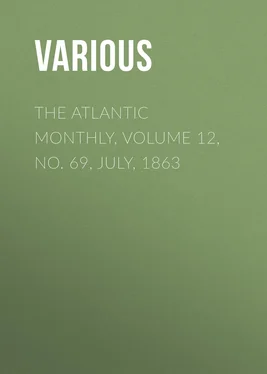Various - The Atlantic Monthly, Volume 12, No. 69, July, 1863
Здесь есть возможность читать онлайн «Various - The Atlantic Monthly, Volume 12, No. 69, July, 1863» — ознакомительный отрывок электронной книги совершенно бесплатно, а после прочтения отрывка купить полную версию. В некоторых случаях можно слушать аудио, скачать через торрент в формате fb2 и присутствует краткое содержание. Жанр: foreign_antique, periodic, foreign_edu, на английском языке. Описание произведения, (предисловие) а так же отзывы посетителей доступны на портале библиотеки ЛибКат.
- Название:The Atlantic Monthly, Volume 12, No. 69, July, 1863
- Автор:
- Жанр:
- Год:неизвестен
- ISBN:нет данных
- Рейтинг книги:4 / 5. Голосов: 1
-
Избранное:Добавить в избранное
- Отзывы:
-
Ваша оценка:
- 80
- 1
- 2
- 3
- 4
- 5
The Atlantic Monthly, Volume 12, No. 69, July, 1863: краткое содержание, описание и аннотация
Предлагаем к чтению аннотацию, описание, краткое содержание или предисловие (зависит от того, что написал сам автор книги «The Atlantic Monthly, Volume 12, No. 69, July, 1863»). Если вы не нашли необходимую информацию о книге — напишите в комментариях, мы постараемся отыскать её.
The Atlantic Monthly, Volume 12, No. 69, July, 1863 — читать онлайн ознакомительный отрывок
Ниже представлен текст книги, разбитый по страницам. Система сохранения места последней прочитанной страницы, позволяет с удобством читать онлайн бесплатно книгу «The Atlantic Monthly, Volume 12, No. 69, July, 1863», без необходимости каждый раз заново искать на чём Вы остановились. Поставьте закладку, и сможете в любой момент перейти на страницу, на которой закончили чтение.
Интервал:
Закладка:
Various
The Atlantic Monthly, Volume 12, No. 69, July, 1863 / A Magazine of Literature, Art, and Politics
DOINGS OF THE SUNBEAM
Few of those who seek a photographer's establishment to have their portraits taken know at all into what a vast branch of commerce this business of sun-picturing has grown. We took occasion lately to visit one of the principal establishments in the country, that of Messrs. E. & H.T. Anthony, in Broadway, New York. We had made the acquaintance of these gentlemen through the remarkable instantaneous stereoscopic views published by them, and of which we spoke in a former article in terms which some might think extravagant. Our unsolicited commendation of these marvellous pictures insured us a more than polite reception. Every detail of the branches of the photographic business to which they are more especially devoted was freely shown us, and "No Admittance" over the doors of their inmost sanctuaries came to mean for us, "Walk in; you are heartily welcome."
We should be glad to tell our readers of all that we saw in the two establishments of theirs which we visited, but this would take the whole space which we must distribute among several subdivisions of a subject that offers many points of interest. We must confine ourselves to a few glimpses and sketches.
The guests of the neighboring hotels, as they dally with their morning's omelet, little imagine what varied uses come out of the shells which furnished them their anticipatory repast of disappointed chickens. If they had visited Mr. Anthony's upper rooms, they would have seen a row of young women before certain broad, shallow pans filled with the glairy albumen which once enveloped those potential fowls.
The one next us takes a large sheet of photographic paper, (a paper made in Europe for this special purpose, very thin, smooth, and compact,) and floats it evenly on the surface of the albumen. Presently she lifts it very carefully by the turned-up corners and hangs it bias , as a seamstress might say, that is, cornerwise, on a string, to dry. This "albumenized" paper is sold most extensively to photographers, who find it cheaper to buy than to prepare it. It keeps for a long time uninjured, and is "sensitized" when wanted, as we shall see by-and-by.
The amount of photographic paper which is annually imported from France and Germany has been estimated at fifteen thousand reams. Ten thousand native partlets—
"Sic vos non vobis nidificatis, aves"—
cackle over the promise of their inchoate offspring, doomed to perish unfeathered, before fate has decided whether they shall cluck or crow, for the sole use of the minions of the sun and the feeders of the caravanseras.
In another portion of the same establishment are great collections of the chemical substances used in photography. To give an idea of the scale on which these are required, we may state that the estimate of the annual consumption of the precious metals for photographic purposes, in this country, is set down at ten tons for silver and half a ton for gold. Vast quantities of the hyposulphite of soda, which, we shall see, plays an important part in the process of preparing the negative plate and finishing the positive print, are also demanded.
In another building, provided with steam power, which performs much of the labor, is carried on the great work of manufacturing photographic albums, cases for portraits, parts of cameras, and of printing pictures from negatives. Many of these branches of work are very interesting. The luxurious album, embossed, clasped, gilded, resplendent as a tropical butterfly, goes through as many transformations as a "purple emperor". It begins a pasteboard larva, is swathed and pressed and glued into the condition of a chrysalis, and at last alights on the centre table gorgeous in gold and velvet, the perfect imago . The cases for portraits are made in lengths, and cut up, somewhat as they say ships are built in Maine, a mile at a time, to be afterwards sawed across so as to become sloops, schooners, or such other sized craft as may happen to be wanted.
Each single process in the manufacture of elaborate products of skill often times seems and is very simple. The workmen in large establishments, where labor is greatly subdivided, become wonderfully adroit in doing a fraction of something. They always remind us of the Chinese or the old Egyptians. A young person who mounts photographs on cards all day long confessed to having never, or almost never, seen a negative developed, though standing at the time within a few feet of the dark closet where the process was going on all day long. One forlorn individual will perhaps pass his days in the single work of cleaning the glass plates for negatives. Almost at his elbow is a toning bath, but he would think it a good joke, if you asked him whether a picture had lain long enough in the solution of gold or hyposulphite.
We always take a glance at the literature which is certain to adorn the walls in the neighborhood of each operative's bench or place for work. Our friends in the manufactory we are speaking of were not wanting in this respect. One of the girls had pasted on the wall before her,
"Kind words can never die."
It would not have been easy to give her a harsh one after reading her chosen maxim. "The Moment of Parting" was twice noticed. "The Haunted Spring", "Dearest May", "The Bony Boat", "Yankee Girls", "Yankee Ship and Yankee Crew", "My Country, 'tis of thee", and—was there ever anybody that ever broke up prose into lengths who would not look to see if there were not a copy of some performance of his own on the wall he was examining, if he were exploring the inner chamber of a freshly opened pyramid?
We left the great manufacturing establishment of the Messrs. Anthony, more than ever impressed with the vast accession of happiness which has come to mankind through this art, which has spread itself as widely as civilization. The photographer can procure every article needed for his work at moderate cost and in quantities suited to his wants. His prices have consequently come down to such a point that pauperism itself need hardly shrink from the outlay required for a family portrait-gallery. The "tin-types," as the small miniatures are called,—stanno-types would be the proper name,—are furnished at the rate of two cents each! A portrait such as Isabey could not paint for a Marshal of France,—a likeness such as Malbone could not make of a President's Lady, to be had for two coppers,—a dozen chefs d'oeuvre for a quarter of a dollar!
We had been for a long time meditating a devotion of a part of what is left of our more or less youthful energies to acquiring practical knowledge of the photographic art. The auspicious moment came at last, and we entered ourselves as the temporary apprentice of Mr. J.W. Black of this city, well known as a most skilful photographer and a friendly assistant of beginners in the art.
We consider ourselves at this present time competent to set up a photographic ambulance or to hang out a sign in any modest country town. We should, no doubt, over-time and under-tone, and otherwise wrong the countenances of some of our sitters; but we should get the knack in a week or two, and if Baron Wenzel owned to having spoiled a hat-full of eyes before he had fairly learned how to operate for cataract, we need not think too much of libelling a few village physiognomies before considering ourselves fit to take the minister and his deacons. After years of practice there is always something to learn, but every one is surprised to find how little time is required for the acquisition of skill enough to make a passable negative and print a tolerable picture. We could not help learning, with the aid that was afforded us by Mr. Black and his assistants, who were all so very courteous and pleasant, that, as a token of gratitude, we offered to take photographs of any of them who would sit to us for that purpose. Every stage of the process, from preparing a plate to mounting a finished sun-print, we have taught our hands to perform, and can therefore speak with a certain authority to those who wish to learn the way of working with the sunbeam.
Читать дальшеИнтервал:
Закладка:
Похожие книги на «The Atlantic Monthly, Volume 12, No. 69, July, 1863»
Представляем Вашему вниманию похожие книги на «The Atlantic Monthly, Volume 12, No. 69, July, 1863» списком для выбора. Мы отобрали схожую по названию и смыслу литературу в надежде предоставить читателям больше вариантов отыскать новые, интересные, ещё непрочитанные произведения.
Обсуждение, отзывы о книге «The Atlantic Monthly, Volume 12, No. 69, July, 1863» и просто собственные мнения читателей. Оставьте ваши комментарии, напишите, что Вы думаете о произведении, его смысле или главных героях. Укажите что конкретно понравилось, а что нет, и почему Вы так считаете.












